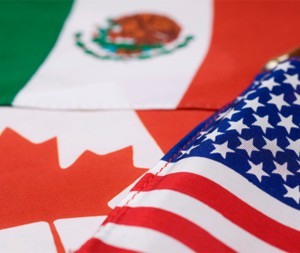The U.S., Canada and Mexico have been participating in renegotiating the North American Free Trade Agreement (NAFTA) for over a year. In the past few weeks, the U.S. and Mexico announced a preliminary agreement and Canada has come back to the negotiating table with the U.S. with the goal of reaching a final agreement by the end of September. All three participating countries agree on one thing – they are better off having no NAFTA agreement if that translates into a bad deal for their country.
Mexico/U.S. Relations
Mexico shares its Northern border with the United States and parts of its South-eastern perimeter with Guatemala and Belize. Mexico is currently the largest trade player in LATAM, according to the WTO. As a worldwide exporter, in 2017, Mexico is ranked 13th with around $409B, and ranked 13th with around $432B in imports.
Mexico’s strengths are found in the automotive, mining and agriculture sectors, ranking in the top 10 globally in these industries (7th globally for cars) and account for 56% of Mexico’s exports.
The U.S. Mexico border has steel fencing that spans about 654 of its 1,933-miles, with some of the areas possessing a “virtual fence,” featuring scanners, guards, and drones. President Trump has proposed a border wall that will potentially cost U.S. taxpayers $67B. Everyone is weighing in on the wall on both sides of the border, with the most vocal voices coming from scientists worried about the impact the wall poses to plant and animal habitats. A letter published in the journal BioScience and endorsed by over 2500 scientists explains that the border wall between the U.S. and Mexico will negatively impact wildlife and “Already-built sections of the wall are reducing the area, quality, and connectivity of plant and animal habitats…” According to James Rogers, “The border bisects areas inhabited by 1,506 native animal and plant species. Some 62 of these species are listed as Critically Endangered, Endangered, or Vulnerable by the International Union for Conservation of Nature (IUCN) Red List.”[1]
Canada/U.S. Relations
The Canada–United States border, officially known as the International Boundary, is the longest international border (at 5,525 miles) in the world between two countries. Canada has more than 100 land border crossings , and currently no walls built between Canada and the U.S.
The Canadian dollar fell against its U.S. counterpart on September 4th after President Donald Trump tweeted on September 1 that the U.S. and Mexico could move forward without Canada in a new NAFTA. “There is no political necessity to keep Canada in the new NAFTA deal. If we don’t make a fair deal for the U.S. after decades of abuse, Canada will be out. Congress should not interfere w/ these negotiations or I will simply terminate NAFTA entirely & we will be far better off…”
Canada’s Foreign Affairs Minister Chrystia Freeland said, “We’re looking for a deal which is good for Canadians, which is good for Canadian workers, which is good for Canadian families (and) good for Canadian farmers.”
NAFTA
NAFTA is the world’s largest free trade agreement. The agreement took effect in January 1994, and essentially eliminated tariffs on most goods traded among the three nations. NAFTA’s purpose was/is to make North America more competitive in the global marketplace. NAFTA took effect under President Bill Clinton, but the framework for the deal was laid years earlier by Ronald Reagan as part of his 1980 presidential campaign platform. President George H.W. Bush signed NAFTA on Oct. 7, 1992, setting the stage for congressional approval of the agreement.[2]
In his first 100 days, President Trump threatened to withdraw from NAFTA if Canada and Mexico refused to renegotiate. The Trump administration wants to lower the trade deficit between the U.S. and Mexico, with all three countries willing to talk because the agreement is perceived as outdated.
Key Points about NAFTA Renegotiation
- Mutual trade totals more than $1 trillion annually
- Update the rule of origins. U.S. wants 75% (up from 62.5) of car parts sold in North America to come from the continent
- S. requests the use of more local steel, aluminum and auto parts, with 40 – 45% of the car made by N. America workers earning at least $16 an hour – a win for labor unions
- Mexico has agreed to raise its de minimis value to $100 USD from $50 USD
- All three countries want a modernized, high-standard Intellectual Property (IP) chapter that provides strong and effective protection and enforcement of IP rights
- Canada and the U.S. are down to three issues: Chapter 19 (dispute resolution)[3], the cultural issues and dairy.
Mexico’s Trade Agreements
There are many reasons why companies moved resources and production into Mexico, but four stand out: Mexico has a stable economy, is strategically located, possesses a skilled lower cost workforce, and participates in a network of trade agreements.
Mexico has been a WTO member since January 1995 and a contracting party to GATT since August 1986. Mexico is the country with the largest network of Free Trade Agreements (FTA’s) in the world; in three different continents/46 countries. Through these treaties, Mexico’s exported products preferentially access a market of 1B consumers (60% of the world’s GDP).
The most important agreement for Mexico is NAFTA as 79% of Mexico’s exports go to the U.S.
Overview of U.S. and Mexico Renegotiation Agreement
The agreement reached between the U.S. and Mexico is simply a revised NAFTA, with updates to provisions surrounding the digital economy, automobiles, agriculture and labor unions. The core of the trade pact, which allows American companies to operate in Mexico and Canada without tariffs, remains intact. If Trump proceeds with the tariffs now under consideration, Mexican duty-free exports of cars and sport-utility vehicles to the United States would be capped at 2.4 million vehicles annually. Volumes above that level would be subject to tariffs.[4]
De minimis: Shipment values up to this level would enter Mexico without customs duties or taxes, and with minimal formal entry procedures, making it easier for more businesses, especially small- and medium-sized ones, to be a part of cross-border trade. Increasing the de minimis level with a key trading partner like Mexico is a critical outcome for United States small- and medium-sized enterprises (SMEs). These SMEs often lack resources to pay customs duties and taxes, and bear the increased compliance costs that low, trade-restrictive de minimis levels place on lower-value shipments, which SMEs often have due to their smaller trade volumes.[5]
Lawmakers are stating that a bilateral pact could lose the benefits of U.S. “fast-track” negotiating authority, which calls for a trilateral deal. A trilateral deal would need only 51 votes in the Senate, while a bilateral pact would need a far more difficult 60-vote threshold. If Republicans retain 51 of the Senate’s 100 seats in November elections, they could approve a new NAFTA agreement next year without the support of Democrats. [6]
Both Canada and Mexico want the U.S. to agree to permanently exempt them from U.S. tariffs on steel and aluminum imports. It is believed Trump used those tariffs as leverage in the NAFTA talks to accelerate meeting his November mid-term deadline.
Trump has notified Congress he intends to sign the trade deal reached with Mexico by the end of November. However, NAFTA negotiations have blown through several deadlines since the talks started in August 2017, so getting the appropriate approvals from Congress to pull out of NAFTA may not be a realistic expectation.
Several members of Congress have suggested that Trump is violating the trade promotion authority (TPA) law if he attempts to submit a deal that only includes Mexico, considering he officially told Congress he was also negotiating with Canada. There are industries and many members of Congress that want a deal that includes Canada.
Conclusion
NAFTA has increased trade and economic growth for all three countries to better compete with China and the European Union. All three countries agree on a revamp of NAFTA and in the last month we have seen the U.S. and Mexico agree to move forward on a bi-lateral agreement, and negotiations with Canada and the U.S. moving positively on concessions to reach an agreement. Are these final negotiations going to harmoniously bring about a new NAFTA and meet the objectives of a better deal for all three countries? Time will tell and if President Trump has his way, this will be before the November mid-term elections in the U.S.
[1]US-Mexico border wall will damage wildlife, scientists warn; By James Rogers | Fox News
[2] What is NAFTA? Seven things to know about the North American free trade pact; by Michael Collins; USA Today
[3] Chapter 19 allows companies that feel their products have been unfairly hit with anti-dumping or countervailing duties to request arbitration. If a panel with representatives from both countries agrees, it can require the return of those duties.
[4] Canada rejoins NAFTA talks as U.S. autos tariff details emerge
[5] UNITED STATES–MEXICO TRADE FACT SHEET Modernizing NAFTA into a 21st Century Trade Agreement
[6] Canada rejoins NAFTA talks as U.S. autos tariff details emerge







